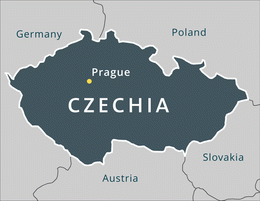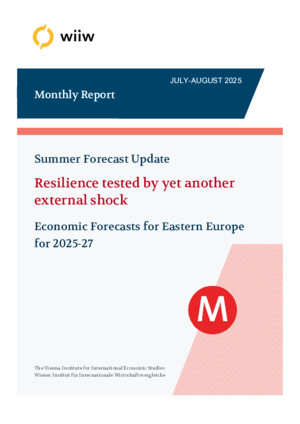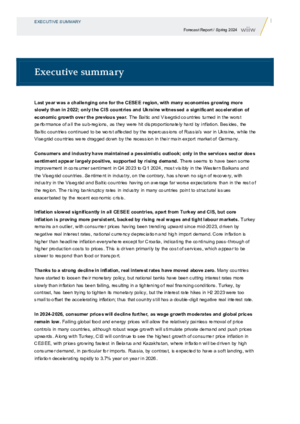Czechia

The Czech economy continued its recovery in Q1 2025, with GDP expanding by 0.8% quarter on quarter and by 2.2% year on year. Growth was driven primarily by household consumption, as improving real incomes and low inflation supported spending. Gross capital formation also contributed positively, reflecting more optimistic business sentiment. By contrast, government consumption declined slightly, and net exports had a neutral impact on growth. Labour market conditions remained favourable. Employment rose by 0.7% compared to the previous quarter and by 1.1% year on year, supported by a pick-up in hiring in services and construction. The average gross wage increased by 6.7% annually in nominal terms, and by 3.9% in real terms, reinforcing the rebound in household purchasing power. Inflation continued to ease in early 2025, reflecting favourable trends in both domestic and external cost pressures. Headline inflation fell to 1.8% in April (the lowest level for seven years), while core inflation remained broadly stable. With price pressures receding, the central bank lowered the two-week repo rate by 25 basis points in May. While further rate cuts remain possible, the bank has signalled a cautious approach, given the global risks and energy market uncertainty. On the political front, former Prime Minister Andrej Babiš’s ANO party maintains a strong lead in the opinion polls. Fragmentation within the ruling coalition has continued, raising the likelihood of an ANO-led government in the forthcoming October elections. Given the Q1 performance and underlying trends in domestic demand, we have maintained our 2025 GDP growth forecast at 2.0%.
| |
|
|
|
FORECAST* |
| Main Economic Indicators | 2022 | 2023 | 2024 | 2025 | 2026 | 2027 |
| Population, 1000 persons | 10672 | 10864 | 10905 | . | . | . |
| GDP, real change in % | 2.8 | 0.0 | 1.2 | 2.0 | 2.4 | 2.7 |
| GDP per capita (EUR at PPP) | 32150 | 34660 | 36440 | . | . | . |
| Gross industrial production, real change in % | 2.1 | -1.3 | -0.7 | . | . | . |
| Unemployment rate - LFS, in %, average | 2.2 | 2.6 | 2.6 | 2.6 | 2.6 | 2.6 |
| Average gross monthly wages, EUR | 1625 | 1796 | 1838 | . | . | . |
| Consumer prices, % p.a. | 14.8 | 12.0 | 2.7 | 2.1 | 2.0 | 1.6 |
| Fiscal balance in % of GDP | -3.1 | -3.7 | -2.2 | -2.4 | -1.9 | -1.8 |
| Public debt in % of GDP | 42.5 | 42.2 | 43.3 | . | . | . |
| Current account in % of GDP | -4.7 | -0.1 | 1.7 | 1.8 | 1.6 | 1.5 |
| FDI inflow, EUR m | 8729 | 11010 | 12048 | . | . | . |
| Gross external debt in % of GDP | 67.4 | 61.0 | 65.3 | . | . | . |
Basic data are continuously updated.
* Forecasts are changed beginning of January, April, July and November.
See Press Conferences.
publication_icon
Monthly Report No. 7-8/2025
Vasily Astrov, Alexandra Bykova, Selena Duraković, Meryem Gökten, Richard Grieveson, Maciej Grodzicki, Ioannis Gutzianas, Doris Hanzl-Weiss, Gabor Hunya, Branimir Jovanović, Niko Korpar, Dzmitry Kruk, Sebastian Leitner, Isilda Mara, Emilia Penkova-Pearson, Olga Pindyuk, Sandor Richter, Marko Sošić, Bernd Christoph Ströhm and Maryna Tverdostup
wiiw Monthly Report No. 7-8, July-August 2025
38 pages including 5 Tables and 3 Figures
Details
publication_icon
Executive summary
Olga Pindyuk
in: The Crisis is Over, but its Scarring Effects are Hindering Recovery
wiiw Forecast Report No. Spring 2024, April 2024 , pp. I-VII
Details
The Czech economy continued its recovery in Q1 2025, with GDP expanding by 0.8% quarter on quarter and by 2.2% year on year. Growth was driven primarily by household consumption, as improving real incomes and low inflation supported spending. Gross capital formation also contributed positively, reflecting more optimistic business sentiment. By contrast, government consumption declined slightly, and net exports had a neutral impact on growth. Labour market conditions remained favourable. Employment rose by 0.7% compared to the previous quarter and by 1.1% year on year, supported by a pick-up in hiring in services and construction. The average gross wage increased by 6.7% annually in nominal terms, and by 3.9% in real terms, reinforcing the rebound in household purchasing power. Inflation continued to ease in early 2025, reflecting favourable trends in both domestic and external cost pressures. Headline inflation fell to 1.8% in April (the lowest level for seven years), while core inflation remained broadly stable. With price pressures receding, the central bank lowered the two-week repo rate by 25 basis points in May. While further rate cuts remain possible, the bank has signalled a cautious approach, given the global risks and energy market uncertainty. On the political front, former Prime Minister Andrej Babiš’s ANO party maintains a strong lead in the opinion polls. Fragmentation within the ruling coalition has continued, raising the likelihood of an ANO-led government in the forthcoming October elections. Given the Q1 performance and underlying trends in domestic demand, we have maintained our 2025 GDP growth forecast at 2.0%.


